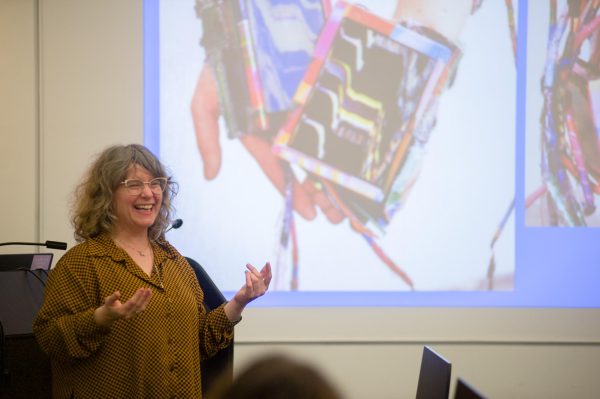Grown-up Losers Club Confronts Evil Clown in “IT: Chapter Two”
Clowns can be fun. They prance around in their absurdly large shoes, make balloon animals, and usually have no qualms about cracking the occasional slapstick joke. However, popular culture has not been kind to this wholesome community, often depicting clowns as the kind of monster that will hide under our beds. If IT Chapter Two can teach us anything, it’s that clowns have feelings too, and all they really want to is to make friends.
It (2017) and its recent sequel follow the story of seven teenagers (known as “The Losers Club”) as they face down Pennywise the Dancing Clown. Played by Bill Skarsgård, Pennywise is a monster shrouded in mystery, inevitably leading to endless exposition that slowly unveils his origins. Over the course of the two films, we become familiarized with his gimmick: he appears every 27 years to feast on unassuming children before presumably going into hibernation. The sequel picks up at the start of such a cycle. The Losers Club, now all grown up and played by a new cast of actors, are still reeling from the trauma of their encounter with a creature from their childhood. Determined to put an end to the clown and his child-eating rituals, The Losers Club embark on personal journeys, confronting their own demons before finally challenging Pennywise.
IT Chapter Two is a film driven almost exclusively by the performance of its core cast. Skarsgård reprises his role with fresh zeal and added depth, delivering an absolutely chilling performance that often keeps the film afloat. Further, the distinctive use of Pennywise’s haunting gaze, both throughout the film and in its promotional material, contribute immensely to the overall effect of the character on the viewer. In an eerie, almost uncomfortable way, we are forced to make eye-contact with Pennywise from the moment we see the poster. This narrative choice challenges audiences with its use of extra-diegetic gaze, while simultaneously justifying the extent of agency attributed to the villain. I do not think it was the film’s intention to have viewers sympathize with Pennywise, but some part of me still does. His dialogue is often rife with emotion and his existence is inherently lonely. Understanding his existential reality provides perspective on why Pennywise thrives on fear, and reimagines his ability to exploit emotions as an acute empathetic sensibility.
Opposing Pennywise in his headstrong yet charismatic way is protagonist Bill Denbrough, an accomplished writer with an affinity for botching endings played by James McAvoy. By far the best-developed character, McAvoy embodies Bill’s emotionally conflicted and torn persona with ease and finesse. The conflict between Bill’s past and ongoing sense of responsibility plays out incredibly through McAvoy’s performance, undeniably becoming the emotional core of the film. Giving McAvoy a run for his money is Bill Hader’s take on Richie Tozier, who has risen from the ranks of irrelevance to become the star of the show whenever he is on screen. With a riveting personal story arc and a unique relationship with Pennywise, Hader brings his best both comically and dramatically.
Unfortunately, the remainder of the Losers were treated with far less care and their arcs were botched by poor plot points. The creative constraints placed on the character of Beverly Marsh felt like a wasted opportunity considering the caliber of actress Jessica Chastain. Almost all of the character traits attributed to Marsh in this film have been rehashed from the original, not to mention the patriarchal tropes that dictate her entire arc. The biggest disappointment, however, was timid mama’s boy Eddie Kaspbrak. Played enjoyably by Jack Dylan Grazer in the previous film, James Ransone’s iteration is deeply lacking in those expressive character traits that made Eddie so endearing. The remainder of the Club was used exclusively to drive subplots and were oftentimes merely plot devices on their own.
A thriller would be incomplete without the execution of its genre-specific tropes. Director Andrés Muschietti maintains the same style of contextual horror as in the first film, relying more on the setting, the emotional distress of the characters, and the tangible psychotic disposition of the antagonist. While he does conjure a few good jump-scares, the dramatic tension of the film is far more effective in the way it maintains a consistent sense of discomfort. Further, the pacing allows Muschietti to add a degree of levity to the story, giving us the opportunity to appreciate the characters outside of their conflict with Pennywise — a narrative choice that pays off in film interest. While IT Chapter Two does subvert traditional horror genre clichés, it does so at the cost of genuinely terrifying set-pieces. While this may dissuade die-hard horror movie-goers, it manages to open the avenue to people less inclined toward the genre. The overall narrative effect is well worth the sacrifice.
IT Chapter Two is a decent film — especially by conventional horror movie standards. Yes, it is important to watch the first film to be able to fully appreciate the nuances of the sequel, but both movies are well-worth the time. While IT Chapter Two does suffer from a number of pitfalls, namely a lack of an effective score and overall cinematographic appeal, the enjoyment gained from watching it outweighs most other factors. It is essential to find a buddy to join you through this experience, and be prepared to suspend disbelief for some ridiculous moments that you can enjoy if you give into the whims of the storyteller. So reach out, believe, and maybe you’ll float too.










